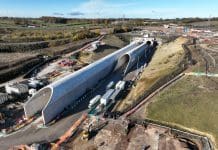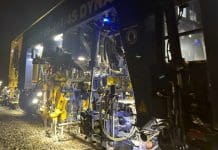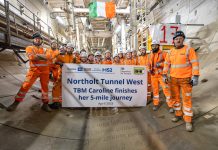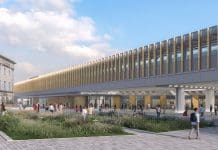HS2 has announced the start of construction of its first innovative green tunnel, which has been designed to blend the railway into the natural landscape
The 2.5km Chipping Warden innovative green tunnel is being built on the surface using off-site manufacturing approaches to speed up construction and improve efficiency.
This approach will see more than five thousand giant concrete tunnel segments made in a factory in Derbyshire before being assembled on site. The completed tunnel will then be covered by earth, with trees, shrubs and hedgerows planted to fit in with the surrounding countryside.
Chipping Warden is one of five innovative green tunnels that are being built on phase one of the HS2 project, which is designed to improve links between London, Birmingham and the north, help level-up the economy and provide a low carbon alternative to car and air travel.
The off-site approach was developed by HS2’s main works contractor, EKFB – a team made up of Eiffage, Kier, Ferrovial Construction and BAM Nuttall.
The tunnel segments are being made by Stanton Precast in Ilkeston Derbyshire as part of a contract which is set to create up to 100 local jobs.
Reducing the amount of carbon embedded in construction
HS2 Ltd’s Project Client, Rohan Perin, said: “The Chipping Warden green tunnel is a great example of what we’re doing to reduce disruption for people living close to the railway – and it’s fantastic to see the first arches in position.
“Our trains will be powered by zero carbon electricity but it’s also important to reduce the amount of carbon embedded in construction. The off-site manufacturing techniques being used will help cutting the overall amount of carbon-intensive concrete and steel in the tunnel and make the whole process faster, more efficient and therefore less disruptive for the community.”
The tunnel has been designed as an m-shaped double arch, and will have separate halves for southbound and northbound trains.
Instead of casting the whole tunnel on site, five different concrete precast segments will be slotted together to achieve the double arch – one central pier, two side walls and two roof slabs.
Concrete and steel are some of the biggest sources of carbon emissions within the construction industry and by reducing the amount of both materials needed for the tunnel, this lighter-weight modular approach is expected to more than halve the amount of carbon embedded in the structure.
HS2 green tunnels are the ‘first of its kind’ in the UK
EKFB’s project manager, Jeremie Martin, added: “Seeing the first set of precast units being installed is a milestone that the whole team is very proud of. This three-year construction programme will benefit from off-site manufacturing making the green tunnel build more efficient than the traditional on-site building method.
“The HS2 green tunnels are a first of its kind in the UK. We have designed them as a twin arch ‘M’ shape which is more efficient than the standard box structure, reducing the amount of concrete required, which is a great example of how innovative engineering design can reduce carbon impact.”
The tunnel will be built in sections, with construction expected to be complete in 2024.
Similar green tunnels will also be built at nearby Greatworth as well as Wendover in Buckinghamshire and Burton Green in Warwickshire, stretching for a combined total of more than four miles.
All 13,290 segments for Chipping Warden, Greatworth and Wendover are being made by Derbyshire-based Stanton Precast Ltd, in a deal that is set to create up to 100 jobs at their Ilkeston factor.




![[Video] Fireco: 80 new fire doors required for residential flats in London](https://www.pbctoday.co.uk/news/wp-content/uploads/2025/04/2024-06-01-Lords-view-one_1200x750_004-218x150.webp)
![[VIDEO] Cambridge waste water plant granted permission to relocate Artist impression of the new Cambridge waste water plant and surrounding land](https://www.pbctoday.co.uk/news/wp-content/uploads/2025/04/p.151-768x364-1-218x150.jpg)







![[VIDEO] Re-flow Field Management review by Traffic Management Installations When TMI began subcontracting for councils and government bodies, they wanted to present their site reporting in a more professional manner](https://www.pbctoday.co.uk/news/wp-content/uploads/2025/03/TMI-Media-1-218x150.png)
